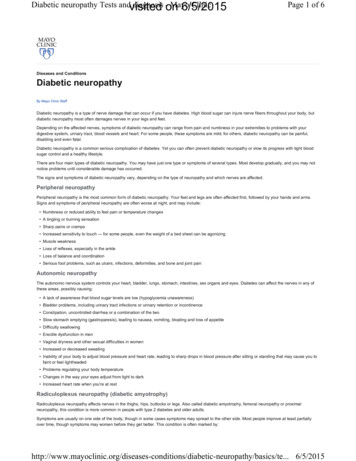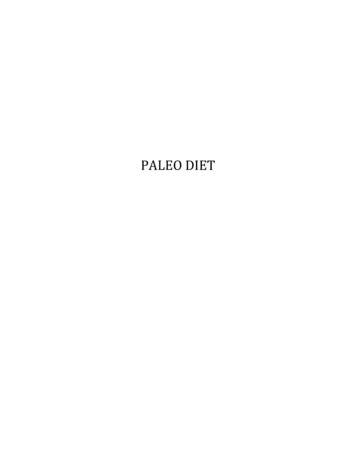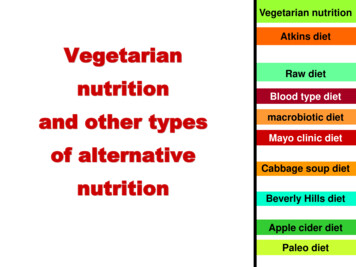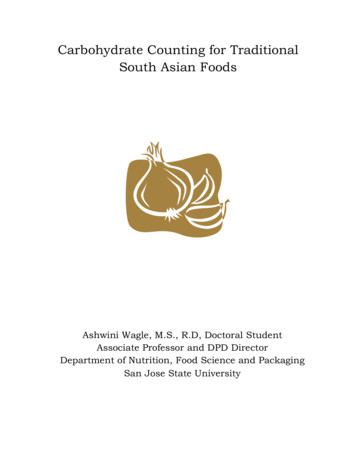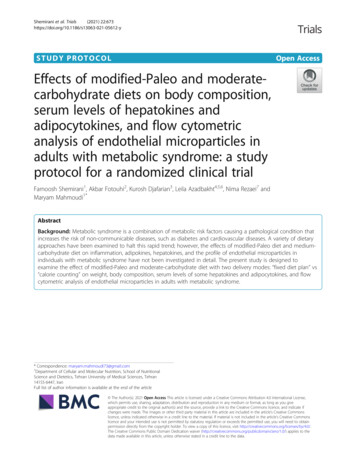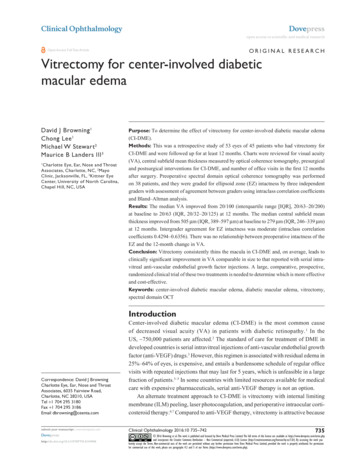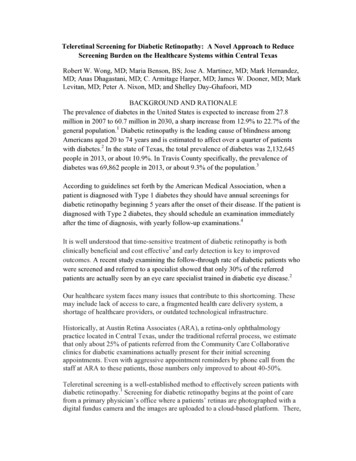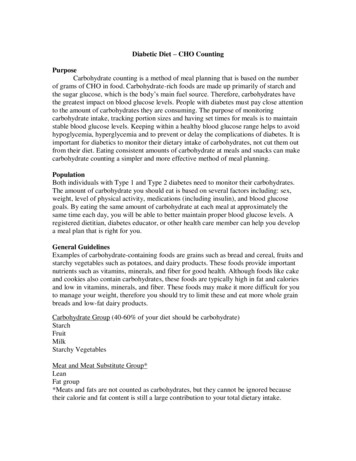
Transcription
Diabetic Diet – CHO CountingPurposeCarbohydrate counting is a method of meal planning that is based on the numberof grams of CHO in food. Carbohydrate-rich foods are made up primarily of starch andthe sugar glucose, which is the body’s main fuel source. Therefore, carbohydrates havethe greatest impact on blood glucose levels. People with diabetes must pay close attentionto the amount of carbohydrates they are consuming. The purpose of monitoringcarbohydrate intake, tracking portion sizes and having set times for meals is to maintainstable blood glucose levels. Keeping within a healthy blood glucose range helps to avoidhypoglycemia, hyperglycemia and to prevent or delay the complications of diabetes. It isimportant for diabetics to monitor their dietary intake of carbohydrates, not cut them outfrom their diet. Eating consistent amounts of carbohydrate at meals and snacks can makecarbohydrate counting a simpler and more effective method of meal planning.PopulationBoth individuals with Type 1 and Type 2 diabetes need to monitor their carbohydrates.The amount of carbohydrate you should eat is based on several factors including: sex,weight, level of physical activity, medications (including insulin), and blood glucosegoals. By eating the same amount of carbohydrate at each meal at approximately thesame time each day, you will be able to better maintain proper blood glucose levels. Aregistered dietitian, diabetes educator, or other health care member can help you developa meal plan that is right for you.General GuidelinesExamples of carbohydrate-containing foods are grains such as bread and cereal, fruits andstarchy vegetables such as potatoes, and dairy products. These foods provide importantnutrients such as vitamins, minerals, and fiber for good health. Although foods like cakeand cookies also contain carbohydrates, these foods are typically high in fat and caloriesand low in vitamins, minerals, and fiber. These foods may make it more difficult for youto manage your weight, therefore you should try to limit these and eat more whole grainbreads and low-fat dairy products.Carbohydrate Group (40-60% of your diet should be carbohydrate)StarchFruitMilkStarchy VegetablesMeat and Meat Substitute Group*LeanFat group*Meats and fats are not counted as carbohydrates, but they cannot be ignored becausetheir calorie and fat content is still a large contribution to your total dietary intake.
Some common serving sizes are listed below, based on 15 grams of carbohydrate: 1 small piece of fresh fruit (4 oz) 1 slice of bread (1 oz) 1/2 cup of oatmeal 1/3 cup of pasta or rice 4-6 crackers 1/2 cup of black beans or starchy vegetable 2 small cookies 1/2 cup ice cream or sherbet 1 Tbsp syrup, jam, jelly, sugar or honey 2 Tbsp light syrup 6 chicken nuggets 1 cup of soup 1/4 serving of a medium French fryThree Levels of Carbohydrate CountingLevel 1: Basic Carbohydrate Counting SkillsKnowing carbohydrate sourcesKnowing how to count grams of carbohydrate in foodsUnderstanding the relationship between portion size and carbohydrate contentRecording your usual carbohydrate intake and sharing it with an RDDetermining target amounts of carbohydrates for meals and snacks determinedLevel 2: Intermediate Carbohydrate Counting SkillsPattern management- Identify blood glucose patterns impacted by food, insulin, and PA- Identify and interpret patterns to make adjustments in diabetes regimensRapid of short-acting insulins matched to carbohydrate content of usual mealsInsulin doses adjusted when deviations from usual carbohydrate content are made- For every 15-20 g CHO added or subtracted from a meal, 1-2 units rapid- orshort-acting insulin suggested.- Each person’s requirements should be individualizedLevel 3: Advanced Carbohydrate Counting SkillsUsed by individuals on intensive insulin therapyInsulin adjusted on basis of ratio of grams of carbohydrate intake to doses of rapid orshort-acting insulinRD calculates carbohydrate-to-insulin ratio for each meal- Uses food, insulin, blood glucose monitoring records- Ratios may vary from meal to meal, from workdays to weekend days, fromexercise to non-exercise days, and they may change over time
- Periodic reevaluation is requiredCalculation of carbohydrate-to-insulin ratios- Grams of CHO eaten at a meal divided by number of units of rapid- or shortacting insulin necessary to meet blood glucose goals. For example:- 45 g CHO (3 CHO choices) at a meal and requires 5 units insulin- Ratio of 1 U insulin to 9 g CHO or 2 U insulin for every 1 carbohydrate choiceThere may be need for food-specific insulin dosesLarge amounts of meat and/or fat at a meal may require adjustment of insulinadministration after the meal instead of before the mealGrams of fiber may be subtracted from total carbohydrate content of a food if itcontains 5 g fiber per serving, since fiber is not considered an available sourceEducation MaterialHow to measure grams of CHO:CHOs are measured in grams15 grams CHO 1 CHO choiceTotal CHO (grams) per day 15 grams CHO number of CHO choices per dayIdeas for Compliance:Making sure that an individual stays within a healthy blood glucose range willprevent the chance of hypoglycemia, hyperglycemia, and many other risk factors.If a person becomes hypoglycemic, they should be given ½ cup fruit juice, ½ cup soda, or3-4 glucose tablets. If a person becomes hyperglycemic, they may need to adjust theirinsulin regimen and/or see a physician if it gets too high, which could cause diabeticketoacidosis or other complications.Reading food labels is a simple and easy way to know how many carbohydratesare in a food. Be sure to pay attention the serving size, in case you would need to doublethe amount of carbohydrate. Also pay close attention to the “total carbohydrate” whichincludes sugar, starch, and fiber. Not all foods are labeled, therefore, it is important to bewell educated so that you can estimate how much carbohydrate is in it. Knowing generalserving sizes will help you estimate how much carbohydrate you are eating.Exercise is encouraged for diabetics because it can improve glycemic control,improve blood lipids and blood pressure with subsequent lower cardiovascular risks andoverall mortality, have a positive impact on metabolic abnormalities characteristic ofT2DM for individuals at high risk for developing diabetes or with pre-diabetes and helpto enhance quality of life.Checking your blood glucose levels before and after eating is important indetermining whether you need to change your meal plan or modify it. Your physicianmay need to make adjustments to your diabetes medications or insulin doses.Sample MenuFoods that contain carbohydrates are: starchy foods like bread, cereal, rice, and crackers fruit and juice milk and yogurt dried beans like pinto beans and soy products like veggie burgers
starchy vegetables like potatoes and corn sweets and snack foods like sodas, juice drinks, cake, cookies, candy, and chips*Non-starchy vegetables have a little bit of carbohydrate but in general are very low.
University of Pittsburgh Medical Center. Basic Carbohydrate cation/Documents/basicCarbCounting.pdfSample MenuAn individual on a 2,000 kcal diet and needs 50% of their intake coming fromcarbohydrate would need 250 grams of carbohydrate per day.2,000 kcals x 50% CHO / 4 kcals/g 250 g CHOWebsitesAmerican Diabetes Association http://www.diabetes.org/MayoClinic.com http://www.mayoclinic.com/The Merck Manual. http://www.merck.com/mmpe/index.html
Diabetic Diet - CHO Counting Purpose Carbohydrate counting is a method of meal planning that is based on the number of grams of CHO in food. Carbohydrate-rich foods are made up primarily of starch and the sugar glucose, which is the body's main fuel source. Therefore, carbohydrates have the greatest impact on blood glucose levels.

